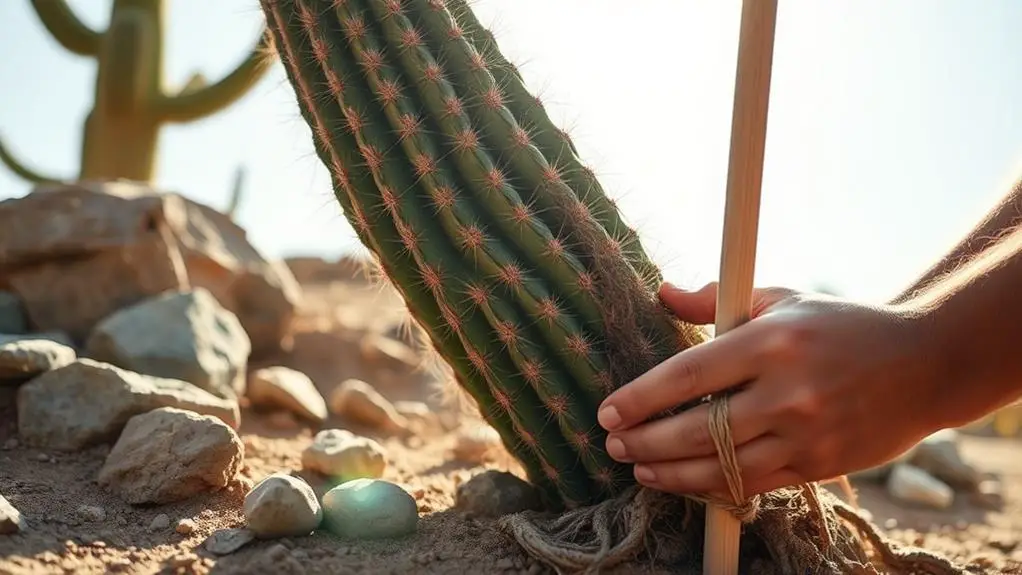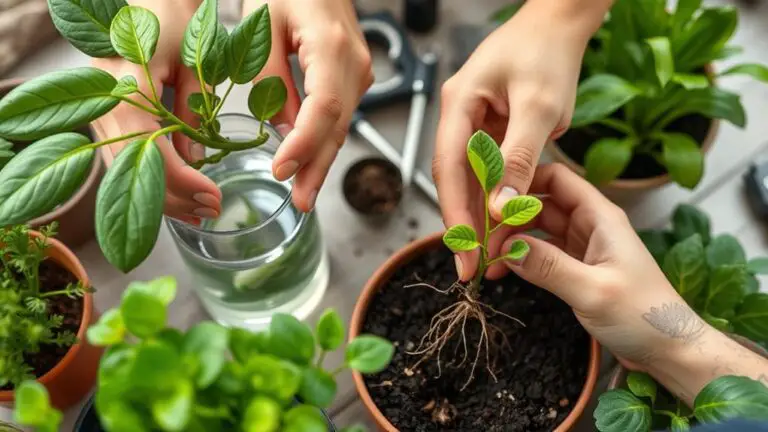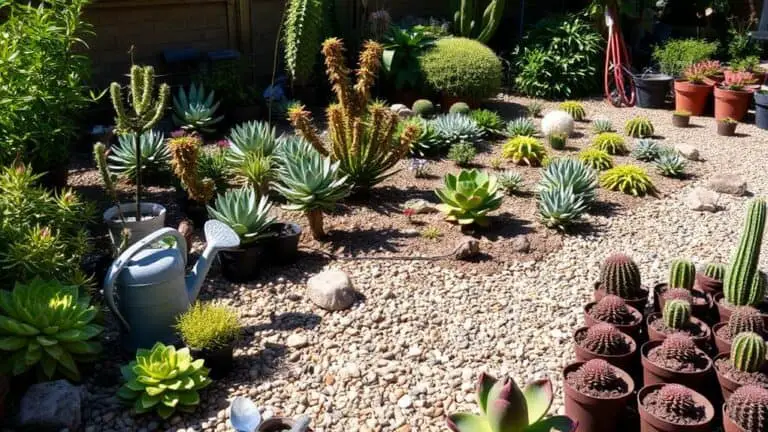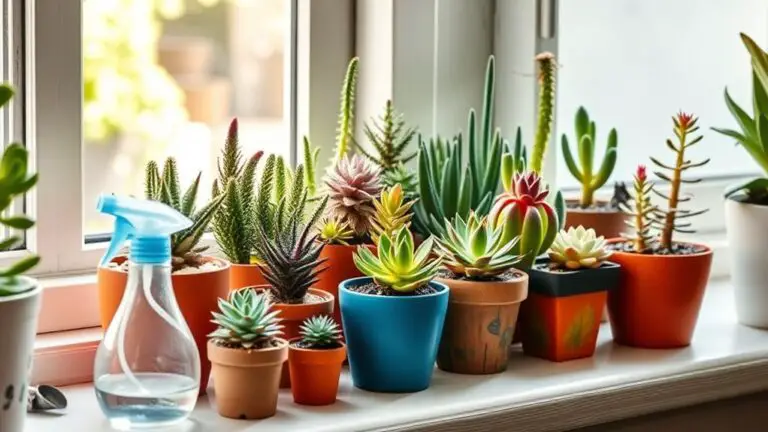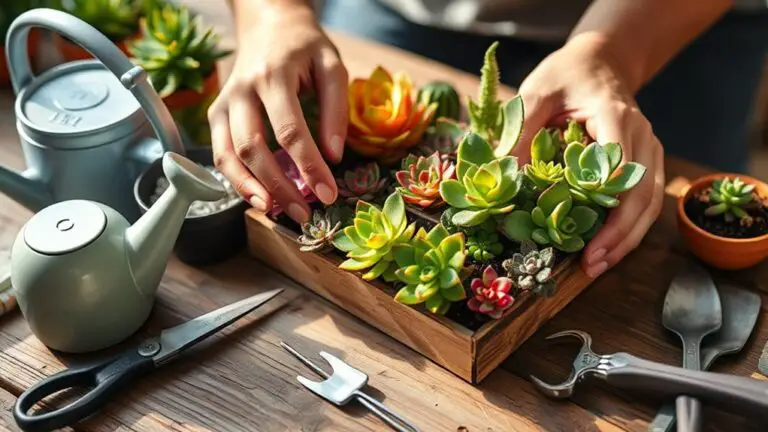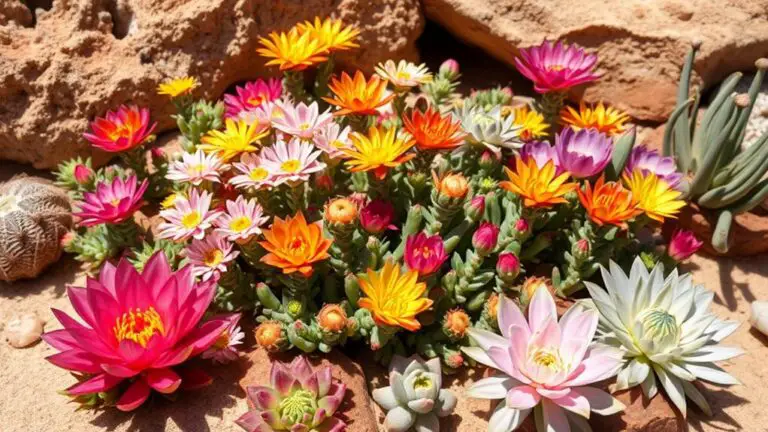What Causes a Cactus to Lean and How to Fix It
When your cactus starts to lean, it's crucial to identify the root cause to restore its upright posture. It could be insufficient sunlight, improper watering, or even fungal infections that are stressing your plant. You'll want to examine your cactus's environment and care routine to pinpoint the issue. Ensuring proper lighting, using well-draining soil, and adjusting your watering habits are just a few steps you can take. But what if the problem persists? There's more to uncover about maintaining a healthy, upright cactus that might surprise you.
Environmental Factors
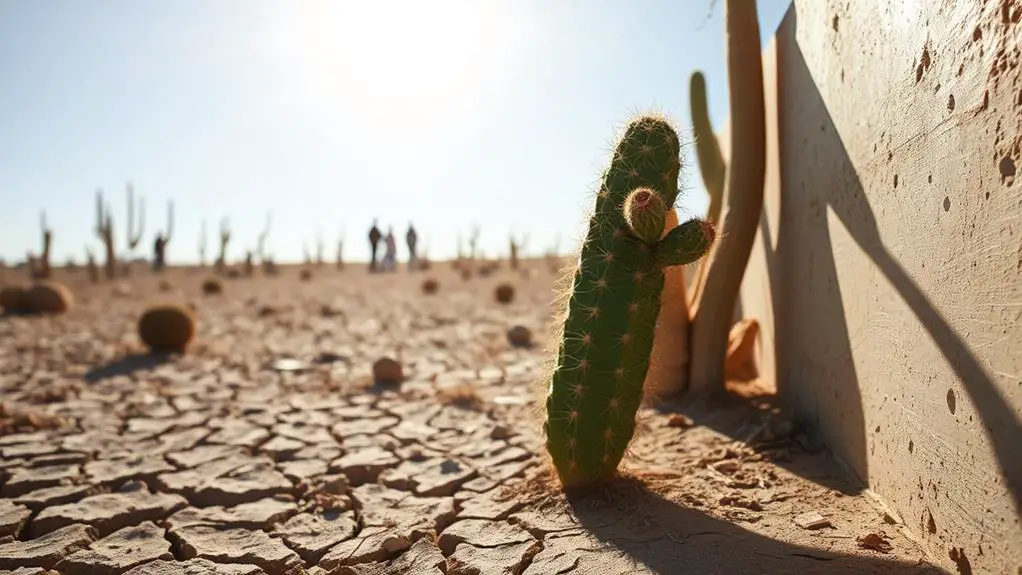
In relation to environmental factors, strong winds and heavy rains can cause your cactus to lean, especially if it's young and has a lightweight structure and shallow roots. These forces can easily push your cactus off balance, making it tilt.
If your cactus is planted on uneven surfaces, it'll naturally lean towards the downhill side over time. Extreme weather conditions can also stress your cactus, weakening its root support and contributing to the leaning problem.
For potted cacti, bringing them indoors during harsh weather or covering them during storms can help prevent leaning and potential damage. Regular maintenance is essential to keep your cactus upright.
Staking your cactus can provide extra support and encourage more upright growth. Rotating your pots regularly will guarantee even exposure to sunlight, which helps maintain balance.
If you notice your cactus leaning, take action quickly to correct its position before the problem worsens. By being proactive and attentive to these environmental factors, you can help your cactus thrive and stay upright.
Watering Practices
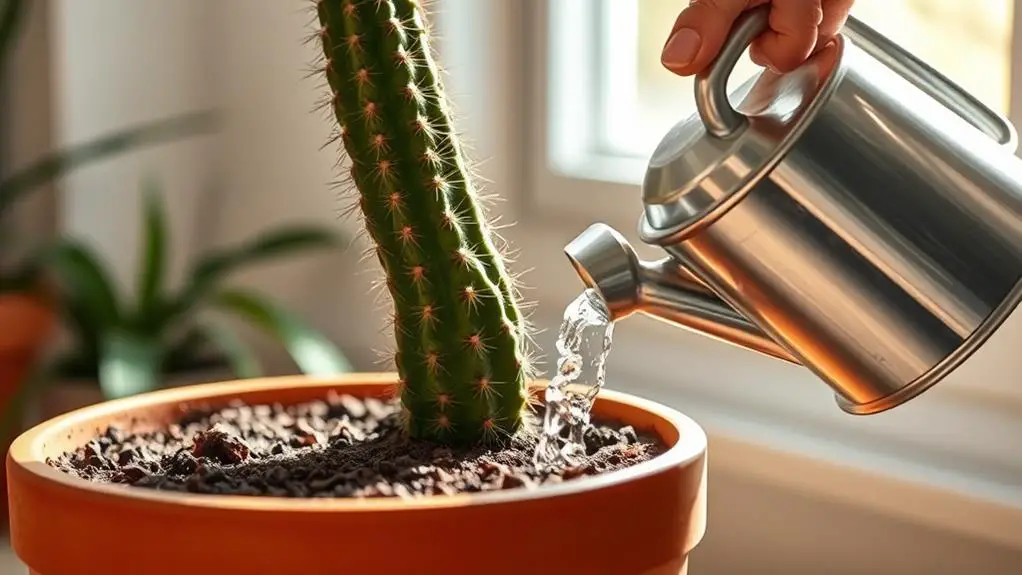
When it comes to watering your cactus, getting it right is key to preventing leaning. Overwatering can lead to root rot and weak anchorage, while underwatering makes roots dry and fragile.
Make sure to water only when the topsoil is completely dry and use pots with drainage holes to keep your cactus stable and healthy.
Proper Watering Techniques
Ensuring proper watering techniques is essential for keeping your cactus healthy and upright. Start by watering only when the topsoil is completely dry. This prevents overwatering, which can cause waterlogged soil and lead to root rot.
Root rot weakens your cactus's structural integrity, making it lean. Always use pots with drainage holes. These allow excess water to escape, preventing moisture from accumulating around the roots.
Well-draining soil is another key factor; it helps water move through quickly, so the roots don't stay wet for too long. Regularly check the soil moisture levels to avoid both overwatering and underwatering.
Too much water can be just as harmful as too little. If your cactus can't stand upright, it may be due to improper watering practices. Overwatering can make the soil too heavy, causing instability, while underwatering may weaken the roots, making it hard for the cactus to support itself.
Allow the soil to dry out completely between waterings. This promotes healthy root development, ensuring your cactus remains strong and upright. By following these proper watering techniques, you'll help your cactus thrive and stay upright.
Preventing Root Rot
Proper watering techniques are just one part of the puzzle; preventing root rot is equally important in maintaining a healthy, upright cactus.
Root rot can cause your cactus to lean and eventually die if not addressed. Here's how you can prevent it:
- Waterings: Only water your cactus when the topsoil is completely dry. Overwatering is a common cause of root rot.
- Soil moisture: Regularly check soil moisture levels. Both overwatering and underwatering can harm root health and cause leaning.
- Drainage: Make sure your pots have drainage holes to allow excess water to escape. This helps prevent water accumulation, which can lead to root rot.
- Soil mix: Use cactus-specific potting mixes that promote good drainage and prevent moisture from hanging around the roots.
If you notice signs of root rot, don't panic.
Repot the cactus in dry soil immediately, trimming away any rotten roots with clean shears. This can encourage recovery and restore your cactus to good health.
By following these steps, you can prevent root rot and keep your cactus standing tall and strong.
Root and Stem Rot

Overwatering is the primary culprit behind root and stem rot in cacti, creating a waterlogged environment that encourages fungal and bacterial growth. When the soil stays too wet, it can lead to root rot, causing your cactus to lean as its stability weakens. You might notice slimy, blackened areas on your cactus, starting at the base and moving upwards. Early detection is essential.
First, you'll want to remove the cactus from the waterlogged soil. Gently shake off the old soil and inspect the roots. If you see any rotting areas, trim away the infected spots with clean shears. This helps stop the spread of disease and promotes healthy growth.
After trimming, look for any signs of fungal growth and apply a fungicide to the remaining healthy areas. This guarantees a better chance of recovery.
Next, repot the cactus in fresh, dry soil. Choose a pot with drainage holes to prevent future waterlogging.
Make sure to water sparingly, allowing the soil to dry out completely between waterings. With these steps, your cactus should regain its strength and stay upright, ensuring it thrives for years to come.
Potting Considerations
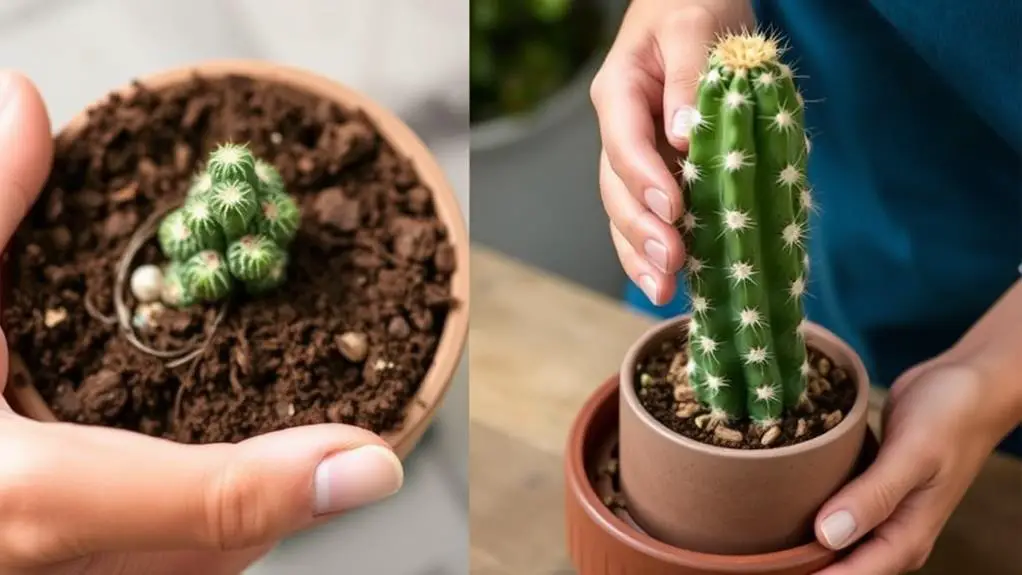
Potting considerations play an essential role in maintaining a healthy, upright cactus. Guaranteeing your cactus stays straight and strong requires attention to pot size, soil mix, and drainage.
- Pot Size: Choose a pot that's just right. Too large, and it retains excess moisture, leading to root rot. Too small, and the cactus's growth is restricted, causing leaning.
- Well-Draining Soil Mix: Use a mix designed for cacti—ideally sandy or gritty. This prevents waterlogging and gives your cactus the support it needs to stay upright.
- Repotting: Regularly repot your cactus every 2-3 years. This guarantees the roots have enough space and the soil remains fresh and suitable. Be gentle during repotting to avoid transplant shock.
- Central Position and Drainage: When placing your cactus in a new pot, position it centrally. Fill any gaps with soil mix and firm it gently. Incorporate gravel or small rocks at the base to improve drainage and provide additional support against leaning.
Lighting Conditions
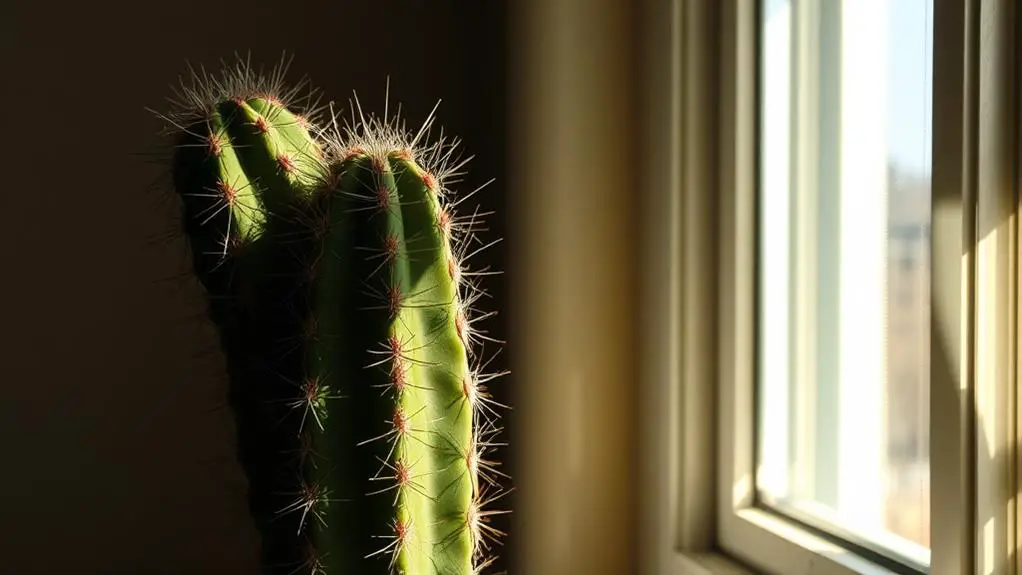
Lighting conditions play a critical role in guaranteeing your cactus remains upright and healthy.
Cacti naturally grow towards sunlight, and if they're not getting adequate light from all sides, they can start leaning. Insufficient light will cause your cactus to stretch and become elongated, resulting in weak stems that lean towards the light source.
To promote upright growth, aim to provide full sun exposure for your cactus. However, even with full sun, your cactus might still lean if it's not rotated regularly. Rotating your cactus guarantees it receives even light distribution, which helps it stay straight.
Watch out for yellowish stems, as this is a sign your cactus needs more light.
If your cactus has been in low-light conditions, don't move it straight into intense sunlight. Gradual exposure to stronger sunlight will help avoid sunburn.
Start by placing it in bright but indirect light and slowly increase the amount of direct sunlight over time. This careful approach helps your cactus adjust and grow strong.
Pest and Disease Management

Pest and disease management is essential for keeping your cactus upright and healthy. Regular inspections help you catch problems early, like pest infestations from mealybugs and spider mites, which can weaken your cactus and cause it to lean.
Fungal infections, often seen as slimy, black areas, indicate rot that compromises the cactus's structural integrity. To manage these issues, follow these steps:
- Quarantine New Plants: Always quarantine new plants before introducing them to your collection. This prevents the spread of pests and diseases, keeping your cacti healthy.
- Prompt Removal of Pests: Use tweezers and alcohol to remove pests like mealybugs as soon as you spot them. Quick action maintains the stability and health of your cactus.
- Maintain Proper Care Routines: Confirm your cactus gets the right amount of watering and light exposure. Healthy cacti are more resilient against pests and less likely to lean.
- Monitor for Signs of Rot: Check regularly for fungal infections. If you see any signs of rot, act quickly to treat the affected areas.
Post-Repotting Care

After repotting your cactus, it's important to give it time to settle before watering to reduce transplant shock.
Gradually expose it to sunlight over the course of a week to help it adjust without getting sunburned.
Keep a close eye on your watering schedule, making sure the soil dries out completely between waterings to prevent root rot.
Gradual Sunlight Exposure
When repotting a cactus, gradually increasing its sunlight exposure is essential to prevent stress and sunburn. Start by placing your newly planted cactus in bright, indirect light, like near a sunny window, for the first few days. This helps the plant acclimate to its new environment without overwhelming it.
To guarantee your cactus thrives, follow these steps:
- Partial Shade: For the first week, keep your cactus in partial shade. This prevents it from leaning and reduces the risk of sunburn.
- Gradual Sunlight Exposure: After a week, slowly introduce more direct sunlight. Move the cactus a little closer to the window each day.
- Monitor for Signs of Stress: Watch for discoloration or wilting. If you notice these signs, pull back on the sunlight exposure to avoid damaging the plant.
- Rotating the Cactus: Rotate the cactus every few days. This guarantees even light distribution, promoting balanced growth and preventing it from leaning towards one side.
Monitor Watering Schedule
Making sure your cactus receives the right amount of sunlight is important, but so is managing its watering schedule post-repotting. After you've repotted your cactus, let it settle for a few days before watering. This helps prevent root disturbance and guarantees stability in its new environment.
When you do start watering, be sparing. Confirm the soil dries out completely between waterings. Overwatering can lead to root rot, causing your cactus to start leaning.
You'll want to monitor the soil moisture regularly. Only water your cactus when the topsoil feels dry. This practice helps maintain healthy roots and prevents bending. It's essential to use a well-draining cactus mix and a pot with drainage holes. Proper drainage assures that excess water can escape, keeping moisture levels ideal.
Gradually increase sunlight exposure after repotting, but avoid direct exposure initially to prevent stress. This gradual approach encourages upright growth.
Frequently Asked Questions
How Do I Fix My Leaning Cactus?
To fix your leaning cactus, repot it in well-draining soil and a slightly smaller pot. Stake it with a bamboo stick, rotate the pot regularly, prune weak sections, and monitor watering to keep the soil dry.
Why Has My Cactus Gone Skinny?
Your cactus has gone skinny because it's not getting enough light, water, or nutrients. Check if it's crowded in its pot or if the soil is too dense. Adjust these conditions to help it grow healthier.
How Do You Fix a Droopy Cactus?
To fix a droopy cactus, check your watering routine, ensuring the soil is dry before watering. Repot in well-draining soil, provide brighter light gradually, and inspect for pests. Allow it to settle before watering again.
How Do You Fatten up a Cactus?
To fatten up your cactus, provide bright, indirect sunlight, and water only when the topsoil is dry. Use a well-draining mix, fertilize during the growing season, and repot every 2-3 years to support healthy growth.
Conclusion
To keep your cactus upright and healthy, make sure it gets enough sunlight and water only when the topsoil is dry. Use well-draining soil and watch for pests or diseases. Repotting every few years helps maintain strong roots. If your cactus starts to lean, gently support it with a stake. By following these simple steps, you'll help your cactus thrive. You've got this—happy gardening!

